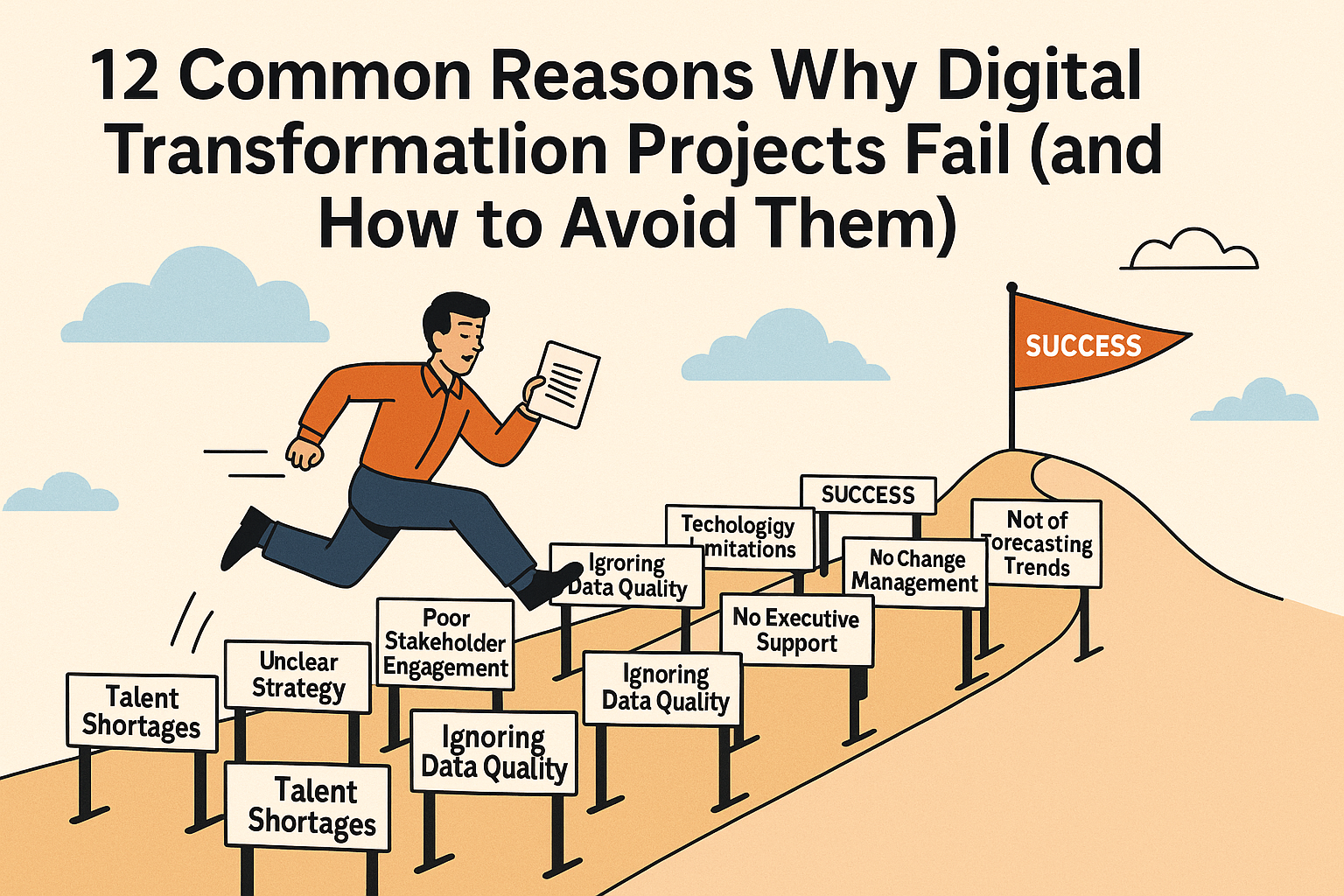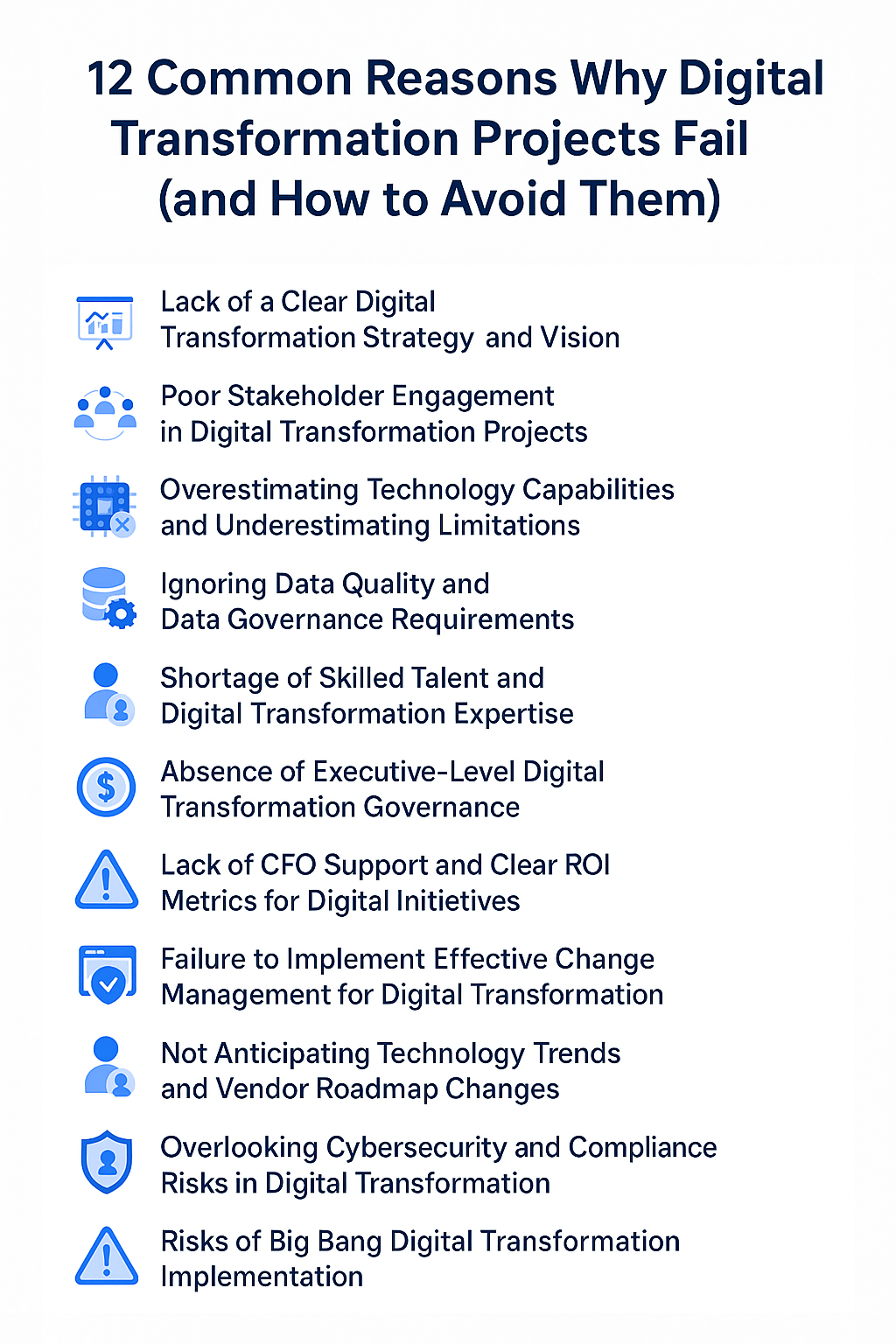12 Common Reasons Why Digital Transformation Projects Fail (and How to Avoid Them)
2025-05-15 · By Anil Kancharla · 9 min read
❤️ 0 Likes · 👁️ 0 Views
 Most digital transformation initiatives risk failing to achieve their intended objectives or encounter significant challenges during execution. Below are the 12 most common reasons why digital transformation projects fail, along with insights on how to avoid these pitfalls.
Most digital transformation initiatives risk failing to achieve their intended objectives or encounter significant challenges during execution. Below are the 12 most common reasons why digital transformation projects fail, along with insights on how to avoid these pitfalls.

Click on each reason to jump to the section:
- 1.Lack of a Clear Digital Transformation Strategy and Vision
- 2.Poor Stakeholder Engagement in Digital Transformation Projects
- 3.Overestimating Technology Capabilities and Underestimating Limitations
- 4.Ignoring Data Quality and Data Governance Requirements
- 5.Shortage of Skilled Talent and Digital Transformation Expertise
- 6.Absence of Executive-Level Digital Transformation Governance
- 7.Lack of CFO Support and Clear ROI Metrics for Digital Initiatives
- 8.Failure to Implement Effective Change Management for Digital Transformation
- 9.Not Anticipating Technology Trends and Vendor Roadmap Changes
- 10.Overlooking Cybersecurity and Compliance Risks in Digital Transformation
- 11.Low User Adoption Due to Lack of Trust and Poor Training
- 12.Risks of Big Bang Digital Transformation Implementation
1. Lack of a Clear Digital Transformation Strategy and Vision
The foundation of any successful digital transformation is clearly understanding what the organization aims to achieve. Too often, companies prioritize adopting the latest technologies without aligning them to core business objectives. Technology alone does not guarantee success—delivering measurable business value and enhancing customer experience must be the ultimate goal of every digital initiative. Many digital transformation projects fail to meet their primary purpose and end with mediocre performance. Organizations must clearly define their long-term business trajectory to avoid this and design a flexible, scalable system architecture that can evolve over time. Engaging business stakeholders and experienced consultants early in the process ensures alignment with proven best practices and industry standards, improving the chances of achieving meaningful outcomes.
2. Poor Stakeholder Engagement in Digital Transformation Projects
There is a well-known principle in human resources management: it is often better for disengaged employees to leave than to stay and remain passively uncooperative. This concept also applies to digital transformation initiatives. One of the most crucial factors for the success of these projects is the active commitment of all stakeholders involved in the transformation journey.
When key business users, IT teams, or project sponsors lack engagement or ownership, the project risks delays, misalignment, and failure. Poor stakeholder engagement is the leading reason digital transformation projects fail. Therefore, top-level leadership ensures that individuals are motivated, informed, and empowered to contribute actively toward achieving the project’s goals.
3. Overestimating Technology Capabilities and Underestimating Limitations
Organizations often get caught up in the excitement of adopting emerging technologies during digital transformation initiatives. However, failing to understand the actual limitations of technology solutions can lead to costly setbacks. For example, implementing OCR (optical character recognition) technology to automate invoice processing is highly desirable. While the technology is powerful, the real challenge lies in onboarding suppliers and ensuring they submit documents correctly. This requires substantial time, training, and ongoing support. Technology alone cannot solve business problems. It is a tool that enables solutions, but success depends on realistic expectations, effective change management, and process alignment. Organizations that recognize this balance are far more likely to achieve success in digital transformation.
4. Ignoring Data Quality and Data Governance Requirements
If you expect outstanding results, you must start with high-quality inputs. Think of a Ferrari—a finely tuned machine that delivers peak performance only with premium fuel. If you run it on poor-quality fuel, performance drops, and eventually, the system fails. The same applies to digital transformation systems. No matter how much effort and investment go into implementing cutting-edge technologies, you will not achieve the expected results if the data quality is poor. Inaccurate, incomplete, or inconsistent data leads to flawed insights, automation failures, and poor decision-making. Organizations must prioritize data governance best practices early in the project lifecycle to prevent these outcomes. Strong data management policies, validation processes, and continuous monitoring are essential for ensuring successful digital transformation outcomes.
5. Shortage of Skilled Talent and Digital Transformation Expertise
Finding the right talent to support the technologies being implemented is critical for both technology selection and long-term system success. The shortage of skilled professionals remains one of the top challenges for organizations undergoing digital transformation. Organizations must develop a proactive human resource strategy to ensure project success and sustainability. In today’s global workforce environment, this includes sourcing talent internationally, promoting cross-skilling among existing employees, and investing in training programs for recent graduates and junior staff. Encouraging continuous learning and maintaining a strong digital transformation talent pipeline helps prevent resource gaps and ensures that the project maintains momentum and long-term value.
6. Absence of Executive-Level Digital Transformation Governance
A strong sense of urgency and active involvement from executive leadership is essential for the success of any digital transformation initiative. When executives prioritize and champion digital projects, it motivates teams and ensures that potential issues are identified and addressed early, before they escalate into significant risks. Establishing an executive steering committee for digital transformation is critical. This committee should meet regularly to review project progress, address challenges, and provide strategic guidance to keep initiatives on track. Strong executive-level governance helps maintain alignment with business objectives, accelerates decision-making, and increases the likelihood of achieving the desired outcomes.
7. Lack of CFO Support and Clear ROI Metrics for Digital Initiatives
Every digital transformation initiative comes with direct and indirect financial implications, as well as potential compliance and audit risks. Without early and active involvement from the finance team, organizations risk incurring unexpected costs or facing regulatory fines later in the project lifecycle. From the beginning, engaging the CFO and finance leadership ensures that the project is aligned with financial controls, budgeting, and compliance standards. Additionally, clearly defining ROI metrics for digital transformation helps build a strong business case, secures ongoing funding, and allows for continuous measurement of value delivered throughout the project.
8. Failure to Implement Effective Change Management for Digital Transformation
Change management is at the heart of any successful digital transformation project. These initiatives almost always trigger significant business process re-engineering, altering how employees perform their daily tasks and interact with systems. Organizations must develop and execute a strong change management strategy to avoid resistance and ensure adoption. This includes proactively guiding and supporting employees through the transition until they become comfortable with the new processes and technologies. Providing clear documentation, structured training programs, and accessible support resources helps employees overcome challenges and increases user confidence. Effective change management is often the difference between digital transformation success and failure.
9. Not Anticipating Technology Trends and Vendor Roadmap Changes
Constant updates, patches, and upgrades are the norm for most digital products today. Often, the original design of a digital transformation initiative can be disrupted by unforeseen changes introduced during product updates. This can lead to costly rework, delays, or design inconsistencies. Organizations must proactively monitor technology trends and stay informed about their vendors’ product roadmaps to mitigate this risk. By anticipating changes in advance, teams can assess potential impacts and take corrective actions before disruptions occur. A structured approach to tracking vendor updates minimizes surprises and helps maintain stability throughout the transformation journey.
10. Overlooking Cybersecurity and Compliance Risks in Digital Transformation
As organizations pursue digital transformation, it is critical to ensure that all initiatives comply with organizational policies, industry regulations, and country-specific compliance requirements. Failure to meet these standards can lead to customer distrust, reputational damage, regulatory fines, and customer churn. To mitigate these risks, organizations must involve cybersecurity and compliance experts early in the planning and design phases. Proactively assessing risks and implementing the necessary safeguards helps protect sensitive data, ensures regulatory compliance, and strengthens customer trust throughout the digital transformation journey.
11. Low User Adoption Due to Lack of Trust and Poor Training
A common challenge in digital transformation projects is the misconception among users that the new system is temporary and that they will eventually return to legacy technologies. This uncertainty, combined with the discomfort of change, can lead to resistance and low adoption rates. To overcome this, organizations must focus on building trust in the new systems and processes. Comprehensive user training programs, clear communication about the purpose and benefits of the changes, and ongoing support are essential. Ensuring that all stakeholders are aligned, comfortable, and confident with the new solution is critical to achieving high user adoption and maximizing the success of the digital transformation initiative.
12. Risks of Big Bang Digital Transformation Implementation
Attempting to digitally transform all business processes at once through a big bang implementation is extremely risky. Organizations often face overwhelming operational issues, resource constraints, and firefighting on multiple fronts. High-profile examples such as Webvan and Hershey illustrate how large-scale, all-at-once transformations can fail disastrously. A better approach is to avoid implementing every possible feature simultaneously. Instead, take a phased, staggered rollout strategy that balances progress with stability. While it’s important not to delay critical capabilities or last-mile processes, a phased approach provides valuable learning opportunities, reduces risk, and increases confidence for future phases. Organizations that implement digital transformation incrementally typically perform better and avoid the costly pitfalls of significant bang failures.
Digital transformation offers tremendous potential to improve business efficiency, enhance customer experience, and drive innovation. However, as outlined above, many organizations face common pitfalls that can derail their efforts. From lack of a clear strategy and poor stakeholder engagement to insufficient change management and cybersecurity risks, these challenges must be proactively addressed. The key to successful digital transformation lies in thoughtful planning, engaging the right stakeholders, ensuring data quality, investing in talent, and adopting a phased approach to implementation. Organizations that anticipate risks, remain adaptable, and focus on delivering real business value will be far more likely to achieve long-term success. By learning from the most common reasons why digital transformation projects fail, you can better prepare your organization to avoid these mistakes and confidently lead your company into the future.
💌 Enjoyed this article?
If you found this post valuable, subscribe to my newsletter for more insights on digital transformation, AI, and business innovation.
👉 Subscribe to the newsletterOr let’s connect on LinkedIn — I share weekly content that’s practical for CIOs, CFOs, and transformation leaders.
🔗 Connect with me on LinkedIn